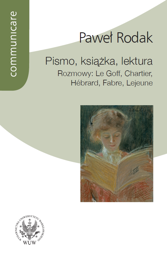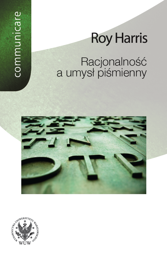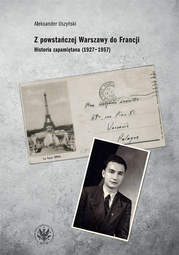Information about a product
| Edition: | 1 |
| Place and year of publication: | Warszawa 2009 |
| Publication language: | polski |
| ISBN/ISSN: | 978-83-235-1511-1 |
| EAN: | 9788323515111 |
| Number of page: | 324 |
| Size of the file: | 2,88 MB |
| Publication type: | Praca naukowa |
| DOI: | https://doi.org/10.31338/uw.9788323515111 |
Orality and mnemonics. Late Baroque in Polish culture
It is a "communicative" story of how the meeting point of orality and literary culture functioned in the Saxon times. Using theoretical apparatus provided by the works of Walter J. Ong, Eric A. Havelock, Frances A. Yates, Edward T. Hall and others made it possible to notice an element of a wider process in the phenomenon of "retreat" of printing in favor of handwritten circulation – an element of counterattack by the world of memory art and orality, being a response to the successes of the spreading analytical world of writing. Both a certain comprehensive model - which we used to call the "age of manuscripts" - and strategies of artistic communication were discussed, for example, late-Baroque "talking" pictures, the proxemic dimension of the old Polish pompae funebris, domination of the episodic plot in the then drama, the habit of communicating ready-made content-versification "prefabricates" by successive generations of contemporary poets or their use of iconographic patterns of memory.
Keywords: orality, literacy, writing, mnemonics, memory, theater.
See other books in the series: Communicare – historia i kultura »
It is a "communicative" story of how the meeting point of orality and literary culture functioned in the Saxon times. Using theoretical apparatus provided by the works of Walter J. Ong, Eric A. Havelock, Frances A. Yates, Edward T. Hall and others made it possible to notice an element of a wider process in the phenomenon of "retreat" of printing in favor of handwritten circulation – an element of counterattack by the world of memory art and orality, being a response to the successes of the spreading analytical world of writing. Both a certain comprehensive model - which we used to call the "age of manuscripts" - and strategies of artistic communication were discussed, for example, late-Baroque "talking" pictures, the proxemic dimension of the old Polish pompae funebris, domination of the episodic plot in the then drama, the habit of communicating ready-made content-versification "prefabricates" by successive generations of contemporary poets or their use of iconographic patterns of memory.
Keywords: orality, literacy, writing, mnemonics, memory, theater.
See other books in the series: Communicare – historia i kultura »
Zobacz również
Polecane



Pismo, tekst, literatura. Praktyki piśmienne starożytnych Greków i matryca pamięci kulturowej Europejczyków (PDF)42,00 zł
14,00 zł
Details
- An attempt at interpreting the history of Greek culture according to the principles of media theory, of constructing local models of culture dynamics emerging under the influence of the means of communication, especially writing practices. The book

Pismo, książka, lektura. Rozmowy: Le Goff, Chartier, Hebrard, Fabre, Lejeune – PDF44,10 zł
14,00 zł
Details
- Książka prezentuje nowe zjawiska we francuskiej humanistyce, które są w Polsce mało znane bądź nieznane. Tematy tych rozmów: sposoby uprawiania nowoczesnej historiografii, oralność, piśmienność, druk w kulturze; książka i lektura jako przedmiot badań

Racjonalność a umysł piśmienny (PDF)36,00 zł
14,00 zł
Details
- An remarkable work of the British linguist in which the author, on the hand, discusses and strengthens the main premises of the theory of orality/literacy, while on the other hand, goes beyond this theory by introducing to it some important modifications

















